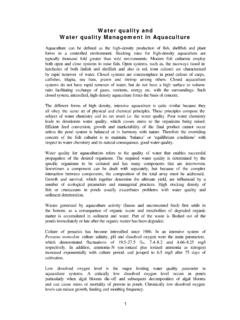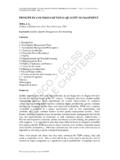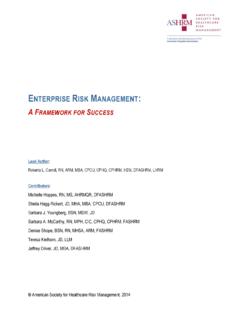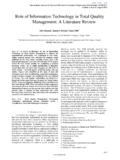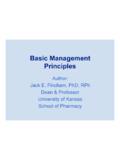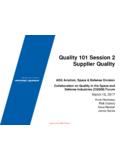Transcription of Total quality management in the construction process
1 ~) Pergamon International Journal of Project management Vol. 15, No. 4, pp. 235-243, 1997 1997 Elsevier Science Ltd and IPMA. All rights reserved Printed in Great Britain 0263-7863/97 $ + PII: S0263-7863(96)00076-2 Total quality management in the construction process David Arditi and H Murat Gunaydin Illinois Institute of Technology, Department of Civil and Architectural Engineering, Chicago, IL 60616, USA There is great potential for quality improvement in the construction process . A study of the literature and of surveys conducted in the USA indicated that management commitment to quality and to continuous quality improvement is very important; construction industry professionals are well aware of the importance of quality training; partnering agreements among the parties in the construction process constitute an important step in securing a high quality product; a feedback loop could upgrade the original quality standards used in the industry.
2 The clarity of project scope and requirements as well as of drawings and specifications is a prerequisite for high process quality . 1997 Elsevier Science Ltd and IPMA Keywords: Total quality management , construction , quality assurance, quality control Attainment of acceptable levels of quality in the construction industry has long been a problem. Great expenditures of time, money and resources, both human and material, are wasted each year because of inefficient or non-existent quality management procedures. The manufacturing industry has developed Total quality management (TQM) concepts, first applied in Japan and in recent years used in the United States, which have increased productivity, decreased product cost and improved product reliability.
3 These concepts are also applicable to the construction industry. For example, Japanese construction companies, benefiting from the ex- periences of Japanese manufacturers, began implementing TQM during the 1970s. Even though construction is a creative, one-time process , the Japanese construction industry embraced the TQM concepts that some argued could only apply to mass production. TQM is an effort that involves every organization in the industry in the effort to improve performance. It permeates every aspect of a company and makes quality a strategic objective. TQM is achieved through an integrated effort among personnel at all levels to increase customer satis- faction by continuously improving performance.
4 TQM focuses on process improvement, customer and supplier involvement, teamwork, and training and education in an effort to achieve customer satisfaction, cost effective- ness, and defect-free work. TQM provides the culture and climate essential for innovation and for technology advancement. In this paper, TQM concepts and their implications in the construction industry will be discussed. Reference will be made to industry surveys conducted in the USA and to the published literature. Definition of quality quality can be defined as meeting the legal, aesthetic and functional requirements of a project.
5 Requirements may be simple or complex, or they may be stated in terms of the end result required or as a detailed description of what is to be done. But, however expressed, quality is obtained if the stated requirements are adequate, and if the completed project conforms to the requirements. Law defines quality in terms of professional liability, a legal concept that requires all professionals to know their trade and practice it responsibly. Every architect and engineer who offers his or her expertise to owners is subject to professional liability laws. Some design professionals believe that quality is measured by the aesthetics of the facilities they design.
6 According to Stasiowski and Burstein, ~ this traditional definition of quality is based on such issues as how well a building blends into its surroundings, a building's psychological impacts on its inhabitants, the ability of a landscaping design to match the theme of adjacent structures, and the use of bold new design concepts that capture people's imaginations. Because aesthetic definitions of quality are largely subjective, major disagreements arise as to whether quality has been achieved or not. Since objective definitions of aesthetic quality do not exist, design professionals generally take it upon themselves to define the aesthetic quality of their designs.
7 quality can also be defined from the view point of func- tion, by how closely the project conforms to its require- ments. Using this definition, a high quality project can be described by such terms as ease in understanding drawings, level of conflict in drawings and specifications, economics 235 Total quality management in construction : D Arditi and H M Gunaydin of construction , ease of operation, ease of maintenance, and energy efficiency. In the construction industry, quality can be defined as meeting the requirements of the designer, constructor and regulatory agencies as well as the owner.
8 According to an ASCE study, 2 quality can be characterized as follows. Meeting the requirements of the owner as to functional adequacy; completion on time and within budget; life- cycle costs; and operation and maintenance. Meeting the requirements of the design professional as to provision of well-defined scope of work; budget to assemble and use a qualified, trained and experienced staff; budget to obtain adequate field information prior to design; provisions for timely decisions by owner and design professional; and contract to perform necessary work at a fair fee with adequate time allowance.
9 Meeting the requirements of the constructor as to provi- sion of contract plans, specifications, and other documents prepared in sufficient detail to permit the constructor to prepare priced proposal or competitive bid; timely decisions by the owner and design professional on authorization and processing of change orders; fair and timely interpretation of contract requirements from field design and inspection staff; and contract for perfor- mance of work on a reasonable schedule which permits a reasonable profit. Meeting the requirements of regulatory agencies (the public) as to public safety and health; environmental considerations; protection of public property including utilities; and conformance with applicable laws, regula- tions, codes and policies.
10 In addition, one should differentiate between ' quality in fact' and ' quality in perception'. The providers of services or goods that meet specifications achieve quality in fact. A service or product that meets the customer's expec- tations achieves quality in perception. 3 In other words, a product can be of high quality and yet it may not meet customer's needs and vice versa. An example of not meeting customer needs is the prefabricated high-rise apartment buildings that were built in the 1970s using cutting edge technology in low-cost building processes. The buildings had to be pulled down in the late 1980s because no one wanted to live in these apartments despite the low rents.
